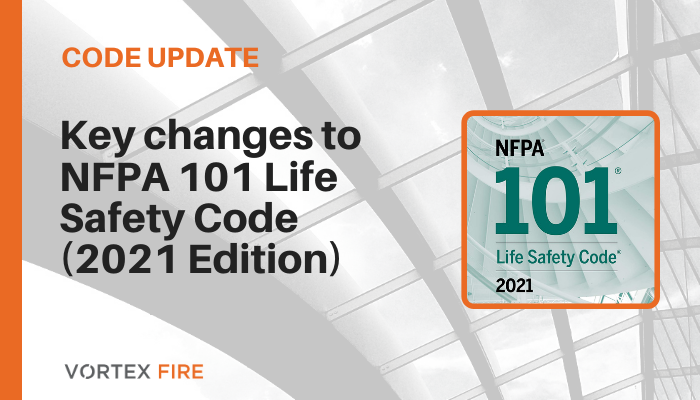NFPA has recently released the 2021 Edition of the NFPA 101 “Life Safety Code”. There are several modifications to the code to improve life safety based on new research and lessons learnt from recent fire incidents. Some of the key changes are highlighted below:
- Means of egress – door latching and locking provisions revised mainly for educational occupancies for security reasons.
- Occupant load factor – replaced special-purpose industrial and storage occupancy occupant load factor from ‘NA’ to ‘Maximum Probable’.
- Mezzanine area – the definition of a mezzanine has been revised to allow up to one-half the open area of the room in which the mezzanine is located (previously this was one-third) if the building is fire sprinkler protected.
- Special Amusement Building – definition has been revised to recognise buildings containing a ride where guests are restrained, and self-evacuation is impractical. The additional classification has been added:
– Class A: permanent structure with rides having patrons restrained and unable to self evacuate;
– Class B: permanent structure with no rides and where patrons are able to self evacuate; and
– Class C: temporary or mobile. - Smoke alarms within sleeping rooms – apartments and hotel occupancies require additional 520 Hz low-frequency notification signals.
- Energy storage systems (ESS) – new provisions requiring energy storage systems to comply with NFPA 855 “Standard for the Installation of Stationary Energy Storage Systems”.
- Highrise buildings generator fuel line protection – new provisions (sub-section 11.8.5.4) for protection of fuel lines supplying generators in high-rise buildings.
- Two-way radio communication – require compliance to NFPA 1221 “Standard for the Installation, Maintenance, and Use of Emergency Services Communications Systems” for radio signal strength.
- Bars & restaurants – all new bars and restaurants must be protected with automatic fire sprinklers regardless of the occupant load.
- Daycare occupancies – all new daycare occupancies must be protected with automatic fire sprinklers.
- Interior wall and ceiling finishes– new provision to require only approved textile or expanded vinyl wall and ceiling coverings (exemption for thickness less than 0.9 mm removed).
- Outdoor furniture – where outdoor furniture is placed beneath combustible exterior projections or overhangs, it must be either fire sprinkler protected or comply with new sub-section 10.4.3.
- Combustible artificial vegetation on roofs & near buildings – must comply with new section 10.5. Does not apply to natural vegetation.
- Mass timber – makes reference to 2021 Edition of NFPA 220 “Standard on Types of Building Construction” permits height increases for mass timber buildings Type IV construction up to 24 storeys or 82.3 m in some occupancies.
- Educational occupancies – must have at least frequent emergency drills (1 per month unless not practical due to climatic conditions). Alternate emergency drills (targeted violence and natural hazard) are permitted with permission from AHJ.
- Maintenance, inspection & testing: new provision permitting records documented using approved reports or forms to be submitted, stored, accessed, and shared electronically.
The updated code is available to view free online at www.nfpa.org/101.
To learn more on the revisions to the NFPA 101 “Life Safety Code” and how it can benefit your project, please contact us.

